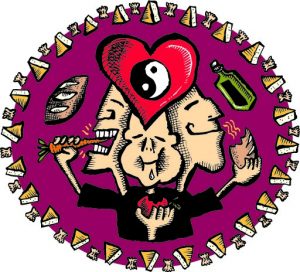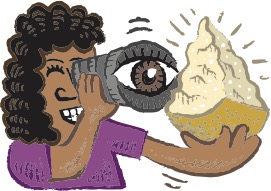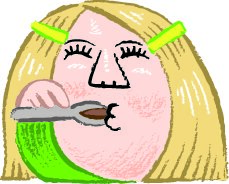Or, How to Taste Food Like an Expert
Adapted from Zingerman’s Guide to Good Eating, by Ari Weinzweig

If we’re going to eat multiple times a day for the rest of our lives, we might as well make our meals as enjoyable and interesting as possible. For a modicum of effort, even the least-experienced eater can easily increase eating enjoyment. The key is to become what Buddhists might call a “mindful eater.”
Activate your senses. Savor. Look for a level of enthusiasm, of excited, focused attention to detail that will carry you to higher levels of culinary consciousness.
Here are some simple steps that all of us follow at Zingerman’s when we taste food. Following the 5 steps (know it, look at it, smell it, taste it, score it) is a way to approach new foods you haven’t experienced before, as well as appreciate tried and true favorites. Anyone can follow them–we even teach them to kids! Armed with this “expert” approach to trying new foods, kids can follow our #1 rule at Zingerman’s–don’t be rude to the food!
STEP 1: KNOW IT
 In the food world, increased knowledge brings increased opportunity for enjoyment. If you learn little to nothing about apples, how can you possibly tell bad from brilliant? Take the apple you bought at the farmers market last week. Its skin is streaked with brown. Does that mean it’s showing signs of excess wear and tear? Or is it supposed to be marked with such rusetting?
In the food world, increased knowledge brings increased opportunity for enjoyment. If you learn little to nothing about apples, how can you possibly tell bad from brilliant? Take the apple you bought at the farmers market last week. Its skin is streaked with brown. Does that mean it’s showing signs of excess wear and tear? Or is it supposed to be marked with such rusetting?
Ask questions: Where does this item come from? How is it used in its homeland? How long is its shelf life? How was it prepared? What should it look like?
Expand your food education by combining travel and learning. If you get the chance, visit your local food producers. Or attend our events and meet them at the Delicatessen! The people who grow or craft the food turn out, time and time again, to be exceptionally interesting individuals. Explore the culture and history of your food.
STEP 2: LOOK AT IT
 Look at ten loaves of artisan bread from the same bakery. If you make time to do a close visual assessment, you’ll quickly notice that each loaf has its own hue. Compare the crust, and what at first appears to be “all brown” will probably become everything from chestnut to cherry wood to chocolate.
Look at ten loaves of artisan bread from the same bakery. If you make time to do a close visual assessment, you’ll quickly notice that each loaf has its own hue. Compare the crust, and what at first appears to be “all brown” will probably become everything from chestnut to cherry wood to chocolate.
Look closely and you’ll find colors in your food that go well beyond the confines of the standard Crayola box: the deep purple-black of an Italian olive paste as you spread it on a golden slice of toasted wheat bread, the nearly Day-Glo emerald green of newly pressed Tuscan olive oil.
External visuals aren’t just about color schemes either. The more you look, the more you learn. If it’s cheese, check the rind for the coarser-looking handmade farmhouse offerings. If it’s tea, look for discernible leaves, usually a sign of something better than the standard shavings or pieces. If its bread, check the bottom — a random, rough surface says it was baked on a stone hearth. If it’s a packaged product, read the label to check the ingredients.
3. SMELL IT
 Aroma isn’t everything, but it’s about as close as you can get to flavor without actually eating since the sense of smell accounts for roughly 90 percent of what you taste. The nose knows what it’s doing: it can detect something like ten thousand different scents. Ever notice how hard it is to taste anything when you’ve got a cold? If you don’t stop to smell your food, to appreciate its aroma, you diminish the fullness of the flavor.
Aroma isn’t everything, but it’s about as close as you can get to flavor without actually eating since the sense of smell accounts for roughly 90 percent of what you taste. The nose knows what it’s doing: it can detect something like ten thousand different scents. Ever notice how hard it is to taste anything when you’ve got a cold? If you don’t stop to smell your food, to appreciate its aroma, you diminish the fullness of the flavor.
Break open a loaf of country bread and put your nose against the surface. (Breaking is better than slicing for scent-gathering, since the sliced surface is so flat that it’s hard to get your nose into the nooks and crannies.) Test the perfume of a potent new olive oil as it rises up from a hot slice of toast. Experience the astounding aroma of a bottle of well-aged balsamic vinegar. Crack open a well-made croissant and stick your nose right inside to catch a whiff of real butter. Or sample the earthy scent of chanterelles, freshly gathered in the woods, before you drop them into a pot of mushroom soup.
4. TASTE IT
 Each of us has about twenty thousand taste buds. Inside each bud, fifty or so cells relay information to a neuron that passes it on to the brain. In general, women have more taste buds (and perhaps better taste?) than men. An infant has many more taste buds than does an adult. Taste buds tend to wear out every ten days or so, and then we replace them, though in our mid-forties we start to show a net taste bud loss. Consequently, our palate becomes jaded as we age, and older people are predisposed to fuller flavors.
Each of us has about twenty thousand taste buds. Inside each bud, fifty or so cells relay information to a neuron that passes it on to the brain. In general, women have more taste buds (and perhaps better taste?) than men. An infant has many more taste buds than does an adult. Taste buds tend to wear out every ten days or so, and then we replace them, though in our mid-forties we start to show a net taste bud loss. Consequently, our palate becomes jaded as we age, and older people are predisposed to fuller flavors.
As you begin, notice that you can sense different flavor components in different parts of your mouth. You’ll detect sweetness primarily in front, toward the tip of your tongue. Sourness starts to show up toward the back along the sides. Bitter comes in all the way at the back. You can taste saltiness all over.
Pay attention to the feel of the food. Is the silver of very fresh goat cheese melting, velvety soft? or the bread crust so crackly and crunchy you can’t sneak a bite for fear of waking someone? Feel the heat of a habanero chile as it sears and sizzles its way across your tongue and leaves your lips aglow. Savor the creaminess of good chocolate–the kind that’s supposed to melt in your hand as well as in your mouth.
Finally, assess the flavor, ultimately the true pleasure of mindful eating. Notice the intricacies, the complexities, the character of marvelously meaty serrano ham from Spain, the silky smooth, mild gaminess of oak-smoked wild Irish salmon; the pleasantly salty, juicy succulence of a great corned beef sandwich.
5. SCORE IT
 As food professionals, scoring what we taste is an absolutely necessary for developing our professional palate and to ensuring that we’re always serving the best quality version of the product to you, our guests. Our product experts and chefs know how corned beef should taste when it’s perfectly cooked, they know an exceptional bottle of olive oil, and they can differentiate between different batches of cheese. Tasting along side someone who has honed their professional palate for years can help someone learn the same skills, and to separate their personal tastes from their professional ones. We score on a scale of 0-10, with 10 being the highest score.
As food professionals, scoring what we taste is an absolutely necessary for developing our professional palate and to ensuring that we’re always serving the best quality version of the product to you, our guests. Our product experts and chefs know how corned beef should taste when it’s perfectly cooked, they know an exceptional bottle of olive oil, and they can differentiate between different batches of cheese. Tasting along side someone who has honed their professional palate for years can help someone learn the same skills, and to separate their personal tastes from their professional ones. We score on a scale of 0-10, with 10 being the highest score.



